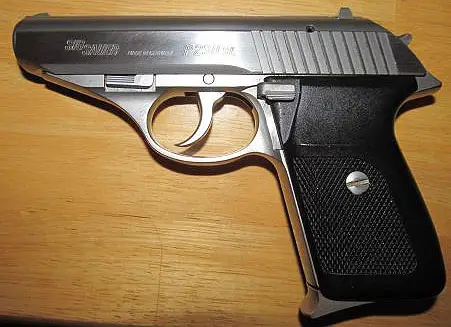|
The SIG SAUER P230 .380 Pistol By David Tong  A previous article on Guns and Shooting Online (see the Product Reviews index page) reviewed the current SIG P232 variation of this handgun. This article is based on my experiences with the pistol from the late 1980's onward. The P230 owes major parts of its general design to the seminal Walther Model PP pistol. The blowback action, its pressed-in barrel secured with a cross pin with the recoil spring wrapped around the barrel and its internal slide stop/ejector were all part of the 1929 pistol that changed the nature of the medium size auto. However, the P230 differs from the PP in several respects and even from its newer P232 descendent. The 230 does not use the hinged trigger guard that commences the field stripping procedure. Instead, the P230 and P232 both use a disassembly lever that operates by rotating it 90 degrees counter clockwise with the slide forward. Then the slide is racked to the rear all the way and lifted upward, then guided forward for removal. Both the 230 and 232 employ a wrap around plastic two-piece grip, much like the 1931 Walther PPK. All three pistols have an abbreviated grip frame, saving an ounce or two in weight. The P230 and P232 dispense with the slide mounted safety/decocking lever of the Walther product, in favor of a simple decocking lever mounted on the frame�s left side for the right handed shooter�s thumb to engage. I find this lever somewhat small and mounted farther forward than the company�s P220 series pistols and harder to use. I think that this lever could have been dispensed with in favor of a slide stop lever to allow closing the slide on a full magazine for faster reloading. The P230 has an integrally machined front sight, like the PP, while the P232 uses the more modern and common dovetailed sight. This allows the P232 the alternative of tritium night sights, although in normal daylight the P230's orangey-red dot over bar von Stavenhagen sights work just fine and are larger and easier to pick up than the Walther PP�s sights. I don�t really care for the heel type German magazine release, though I admit that the necessity for a quick reload on a back-up gun may be pretty slim. P230 Basic Specifications
The P230 and P232 are about the size of the Walther PP pistol and larger than the PPK/S or PPK. This has its advantages in ergonomics and handling. I find the P230 far more comfortable to shoot than the older Walthers, with its fatter rear strap and stocks spreading recoil forces in one�s hands over a larger surface area. Indeed, even the aluminum framed P230 that I shot several months ago felt surprisingly mild for a blowback .380. Oddly enough, I find myself preferring the 230 to the 232 though. One reason is that the smoothly finished stocks on the 230 allow ones palm to find its natural location easier than the fully stippled (and grippier) 232 stock and this aids in instinctive pointing from a holster. The P230 stocks are also better looking, in my view, because their conventional checkering and flat, rather than curved, bottom edges echo the classic style of the PP. The P230�s major fire control parts of hammer, trigger and sear appear to be either machined from stock or from forgings. This is in marked contrast to the P232 that uses MIM produced parts. This is not to say that a properly designed and manufactured MIM part cannot serve long and well, but we all know that a machined part is an old school touch that eloquently speaks of �the way it used to be done.� Finally, while SIG-Sauer, like most of the European pistol manufacturers, have outsourced the production of magazines to the Italian Mec-Gar firm, the P230 came with German magazines. These differ in construction by using the more complex interlocking rectangle/three-spot welded rear spine, rather than the more common seam welded type used to day. The P230's magazines in the stainless pistols are also electroless nickel plated and their aluminum, not plastic, floor plates are retained by a short extension off the magazine spring, rather than the now prevalent retaining plate. The pistol comes with two of these pretty magazines, a color owner�s manual and a signed test target that confirms sight regulation, all contained in a decent hard plastic box. Such things mean little to the modern pistol shooter, but again, these speak about a product that was built more to a standard than a price. The ergonomic excellence of the P230 means that it is very easy to present the properly indexed pistol onto target, without much adjustment. I am no great fan of the 9mm Kurz, believing it more a back up cartridge than a primary round for a legal concealed carry user, even though it was relied upon by European police forces in great numbers. That said, modern .380 JHP ammo offerings, coupled with the superior ergonomics of the P230 and P232, can produce easy and effective hits, which is no small matter when fractions of a second might count. Note: There is a full length review of the SIG P232 on the Product Reviews page. |